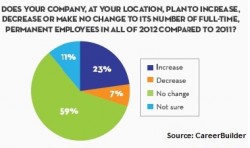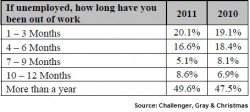 Here, on this first business day of 2012, the new year is still full of promise, and optimism hangs in the air.
Here, on this first business day of 2012, the new year is still full of promise, and optimism hangs in the air.
Consumer confidence is at the highest level in months. The U.S. economy has been adding jobs now for more than a year. When the December report is released Friday, the expectation is that it, too, will show job growth. ADP’s monthly job numbers will be out Thursday morning, offering a preview of what the official U.S. Labor Department employment data may show.
Today, the stock market is up decisively up on reports of strong growth in manufacturing, and increased construction spending. There’s even a cautious willingness among employers to add even more staff this year.
CareerBuilder says that one in four employers plans to add permanent staff this year, about the same number the job board reported for 2011. The 11 percent unsure what they’ll be doing can be read to mean that if the economy improves — as the rising consumer confidence measures suggest the country expects — then even more hiring could be coming.
Manpower’s quarterly employment survey was even a bit more positive. It found that 14 percent of employers intend to add jobs in the first three months of the year, its strongest hiring outlook since 2008.
Consumers, too, are more hopeful. The venerable Consumer Confidence Index has climbed almost 25 points since October. At 64.5, the Index is at its highest point in eight months. The holiday spirit may account for some of that, but there’s also evidence that employment prospects are brightening. The Conference Board’s employment trends index was up 6.4 percent in November compared to the year before. (December’s result will be released next week.)
Last week, Challenger, Gray & Christmas found that 30 percent of the callers to its annual free, phone-in job help line were optimistic they would land a job within three months. In 2010, only 18 percent thought that was the case.
Since June the number of new jobs created each month has been above 100,000. It’s still a slow growth rate, but it’s a significant improvement over 2010 when six out of the 12 months showed job cuts.
“We continue to hear people say that the U.S. recovery is fragile, and that’s the wrong word,” says Michael Gapen, an economist with Barclays Capital. “It’s durable. It’s just not robust. It’s a moderate expansion.”
That’s one reason companies have been hesitant to add permanent staff. It’s also likely that employers recall that after a strong start to 2011, the recovery stalled as the financial markets began recognizing the seriousness of the European debt crises. In the first four months of 2011, some 714,000 jobs were created. Less than half that were created in the next four months.
World economic conditions are still far from stable. Iran is threatening to blockade the Strait of Hormuz, which is starting to send oil futures up. Bank lending hasn’t loosened much and a Presidential election creates more uncertainty about future U.S. economic policy.
With that baggage causing employers to be especially cautious, Monster says that temp hiring is likely to be strong well into 2012. Indeed, in its December report, the American Staffing Association reported that the staffing index has been climbing, slowly, but steadily, since February 2011. The index is now pretty much where it was at the end of last year.
 No wonder, then, that job seekers are tempering their expectations about finding permanent work. That Challenger, Gray & Christmas survey also found that many more job seekers this year expect their job search to last a year. In 2010, 4 percent thought that. This year, 10 percent do.
No wonder, then, that job seekers are tempering their expectations about finding permanent work. That Challenger, Gray & Christmas survey also found that many more job seekers this year expect their job search to last a year. In 2010, 4 percent thought that. This year, 10 percent do.
“There was a lot more uncertainty a year ago. Almost half of last year’s callers had no idea how long the job search would take. This year, callers were either certain of the job market’s improvement or certain of its continued weakness,” said John A. Challenger, CEO of Challenger, Gray & Christmas, referring to the increase in both optimistic and pessimistic callers.
Among the unemployed callers, 37 percent have been out of work for one to six months. Another 14 percent have been jobless for 7 to 12 months. As an indication of how tight the job market remains, the remaining 50 percent of callers had been jobless for a year or more, with 60 percent of these long-time job seekers out of work for two years or longer.
CareerBuilder’s CEO Matt Ferguson predicts a somewhat brighter employment picture for 2012 than the numbers — or the job seeker survey might — imply.
“Historically, our surveys have shown that employers are more conservative in their predictions than actual hiring,” says Ferguson. “Barring any major economic upsets, we expect 2012 to bring a better hiring picture than 2011, especially in the second half of the year.”